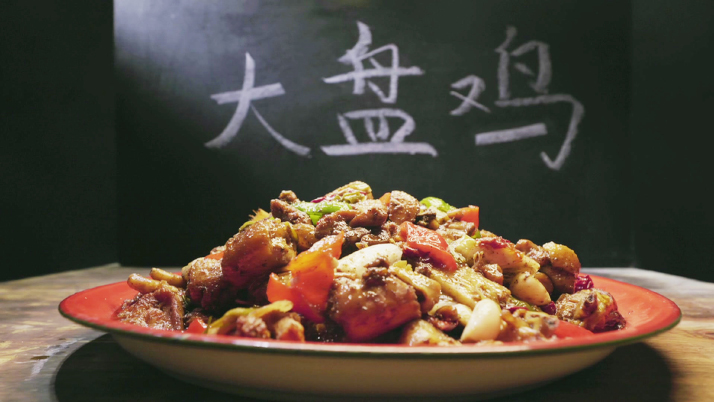| Lifestyle |
| New documentary takes viewers on a food tour of Xinjiang | |
|
|
 Big plate chicken, or da pan ji (SCREENSHOT)
What does the daily diet of Xinjiangers look like? And how did some of these dishes go on to become foodie favorites well beyond the borders of China's westernmost region? The new documentary Tales of Xinjiang Cuisine (Xinjiang Ziwei) paints a full picture of foods from all over Xinjiang Uygur Autonomous Region that will tease the tastebuds of gluttons. Many of its discoveries will even come as a surprise to locals, who may know the recipes by heart, but have never had the chance to explore their origins and evolution. The documentary received tens of millions of views during its first week of airing, May 12-19, both on China Central Television Channel 9, the national documentary channel, and the popular short video sharing platform Bilibili. Going by viewer comments, many were seriously considering traveling to the region just to take an actual bite of food in the mouthwatering images served up in the series. Supersize me If you've ever been to Xinjiang, you know most food comes on big plates to honor guests coming from far and wide; it's a symbol of local generosity and kindness. Big plate chicken, or da pan ji, is a great example thereof as well as a must-eat for travelers and locals alike. In addition to chicken, chili peppers and potatoes, two favorite local ingredients, are the soul of this stir-fried dish. When taking your first bite, you will question every other potato, or even chili pepper dish you've ever tasted. Why did the inventor of da pan ji opt for potatoes, instead of cabbage or mushrooms? How did the dish become popular across the region? Tales of Xinjiang Cuisine went looking for answers. Li Shilin, a chef from Shawan, a hub city in the north of the Tianshan Mountains, was originally famous for his chicken with chili peppers (lazi ji) recipe. Back in the 1980s when the dish started gaining fame, Li figured he could better cater to customer demand by using bigger plates. This time period also denoted the early phase of China's reform and opening up and the region's food and beverage industry began booming as a testament to local economic reforms. Truck drivers usually set off from Urumqi, Xinjiang's capital, in the morning and ran through National Highway No.312 from east to west. When arriving at Shawan, the time was right for a spot of lunch. Restaurants near the highway in Shawan all wanted to stay ahead of the competition, offering the drivers something hearty and filling. The truck drivers coming and going became the first big plate chicken diners and like food bloggers avant la lettre spread the recipe in the 1990s. Ever since it was created, the dish never lacked in chili peppers, which are widely planted in Shawan, particularly in Anjihai, a small town renowned for growing thin cayenne peppers. According to Shawan's local records, it was General Zuo Zongtang's Xiang (Hunan Province) Army in the late Qing Dynasty (1644-1911) that first introduced peppers to Anjihai, where raising chickens is one of the main sources of income. In 1994, seven years after Li started supersizing plates, another local chef called Gao Chuanke was asked by some truck drivers to add more ingredients to the dish. "Only having meat could get boring," Gao said in the documentary's first episode. Gao tried adding cabbage, eggplant, celery, beans, and even frozen tofu, but diners still weren't satisfied. Gao eventually decided to throw in some diced potatoes and got a thumbs-up. Affordable potatoes are rich in starch and absorb the flavor from the soup. Gao's random addition was quickly accepted by many other chefs in the region, and beyond, including his competitor, Li Shilin. Today, big plate chicken, a classic bite of Xinjiang that blends many serendipitous innovations and efforts, tops the menu of many a Xinjiang restaurant.  Extreme naan challenge: a Hotan naan business owner whips up a giant flatbread in burning sand (SCREENSHOT)
Nurtured by nature Xinjiang is highly varied in its geography. Generally, the region is divided by three mountains, Tianshan in the middle, Altai in the north, and Kunlun in the south, with two basins—Junggar and Tarim—in between. "The same crop grown in different parts of Xinjiang can significantly differ in its acidity and sweetness. Therefore, the same ingredients can be cooked in very distinctive ways," First Director of the documentary Xu Xiaohui explained. For example, lamb on the Pamir Plateau, which lies 4,500 meters above sea level in west Xinjiang, is usually boiled by the Kirgiz people because of the higher altitude and thus lower boiling point—courtesy of a drop in atmospheric pressure. The Uygur people from Toksun County in the east of the region prefer steaming their lamb, given theirs is the only county in China that is at sea level. The Tianshan Mountains help people living along their different sides create distinctive methods of cooking. Kazak herders in the north cook their naan in pans with cow manure serving as fuel, while southern Uygur farmers living near the desert bake theirs by burying the flatbread in burning sand. The more widely accepted naan is cooked in a tandoor-shaped oven. Recent years have seen the rise of Kuqa naan, a thin and big flatbread that has won national fame with the expansion of the region's tourism industry. "Xinjiang's geography is complicated, but every area enjoys its characteristic features and so it's not that hard to identify the food's origins," Xu said.  Tajik people living on the Pamir Plateau enjoy a family gathering (COURTESY PHOTO)
A taste to remember It took the documentary crew three years to finish the film, presenting the inclusiveness of Xinjiang cuisines—shooting from mountains to basins, from grasslands to deserts, from A to Z. The difficulties of fulfilling the visual dream of Kurbanjan Samat, Producer and Second Director of Tales of Xinjiang Cuisine, stretched far beyond his original estimates in 2018. The team started shooting in early 2019. However, not long after he was getting excited about having veteran directors getting onboard the project, the COVID-19 pandemic spread in early 2020. The one-year project was postponed again and again, finally gathering the best moments of stories from the land of 1.66 million square km. "The conclusions from our research and the shooting process coincided with my initial impression that frequent exchanges have enriched overall Xinjiang culture," Kurbanjan said. "We recorded the different tastes and their underlying stories," he said, adding that this documentary was a way of sealing in the regional flavor for safekeeping. (Print Edition Title: Sealing in the Flavor) Copyedited by Elsbeth van Paridon Comments to ffl@cicgamericas.com |
|
||||||||||||||||||||||||||||
|
